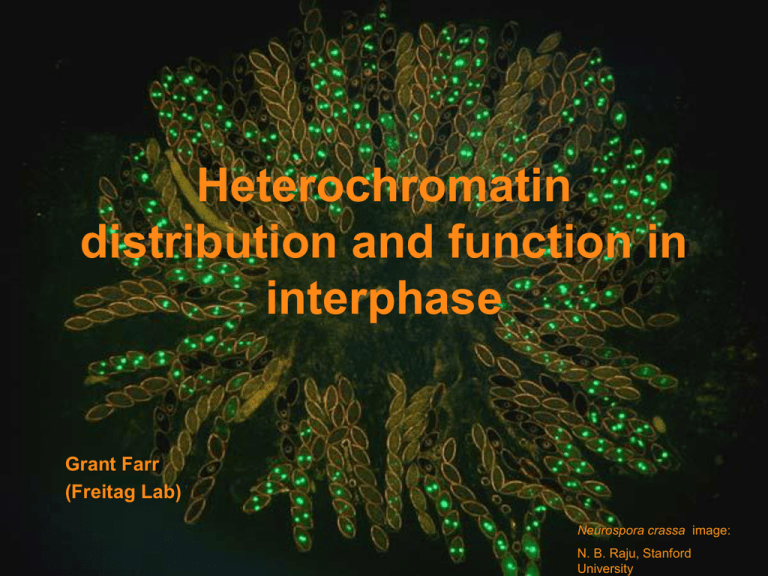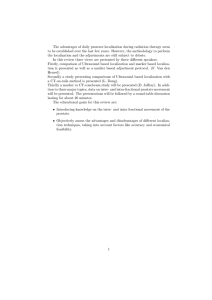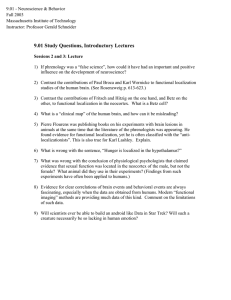Heterochromatin distribution and function in interphase Grant Farr
advertisement

Heterochromatin distribution and function in interphase Grant Farr (Freitag Lab) Neurospora crassa image: N. B. Raju, Stanford University Long-term objectives To find fungus-specific inhibitors to better combat fungal infections in humans, animals and plants. To determine if centromere and heterochromatin organization are involved in polarized growth. Aspergillosis X-Ray by ADAMS Health Care Center Neurospora crassa Vegetative cycle Histone H1-GFP tagged nuclei M. Springer Polarized hyphal growth Histone H1-GFP tagged nuclei Chromatin is heterogeneous euchromatin decondensed, active, DNA unmethylated histones hyperacetylated heterochromatin condensed, inactive, DNA methylated histones hypoacetylated Arabidopsis Wolffe (1998) Chromatin fission yeast mouse Nuclear architecture Chromocenter Region of heterochromatin that may be associated with the telomeres HP1-GFP Histone H1-GFP Role of heterochromatin in polarized growth HP1 mutants exhibit slow linear growth Centromere-specific proteins CENP-A (CenH3) Centromere-specific histone H3 Other proteins: ~30 proteins (CENP-B to CENP-S) in humans ~60 known proteins in yeast Neurospora shares four identifiable proteins with humans: CenH3 Cenp-I Cenp-S CAC-3 (CAFp46/48) Young-Tae Chang and Young-Soo Kim from NYU department of Chemistry Experimental outline 1. PCR 2. Digest plasmid and insert 5’ 3’ 3. Ligate XbaI BamHI 3. Transformation into competent E.coli pMF272 pGF1 DH5 DH5 DH5 6. Analysis by epifluorescent microscopy 4. Purify DNA, linearize 5. Transform N. crassa Amplification of genes for centromere-specific proteins M + all three genes were amplified successfully + Cenp-S was fused to GFP + Cenp-I was fused to RFP + CAC-3 fusions did not work 3.0 kb 2.0 kb 1.0 kb 0.5 kb CCG1 promoter RFP Cenp-I CCG1 promoter Cenp-S GFP C-Terminus C-Terminus CENPS CENP-I CAC-3 Transformation of Neurospora crassa Transformed linearized plasmid DNA carrying Cenp-S and Cenp-I fusion genes into two N. crassa strains each Genes targeted to the his-3 locus Initial transformations of Cenp-S Initial transformation of CENP-I Backcross to purify strains Uncrossed CENP-I RFP Crossed CENP-I with expected localization and less background noise A.J.F. Griffiths, U.B.C. Crosses: Cenp-S-GFP Cenp-S-GFP X X N2557 (rid his-3 mat a) N2556 (his-3 mat a; hpoRIP2) RFP-Cenp-I RFP-Cenp-I X X N2557 (rid his-3 mat a) N2556 (his-3 mat a; hpoRIP2) Cenp-S labels the centromere The HP1 cells previously characterized have similar localization. CenH3 localization is identical to Cenp-S localization. Cenp-S is identified as a part of the centromeric Cenp-A complex. HP1 labeled with centromere and telomeric regions fluorescing Cenp-S-GFP Imaging of the Labeled Centromeres Cenp-S gfp localized at the centromere Centromeric localization of Cenp-S Imaging of the Labeled Centromeres Cenp-I localized in the centromeric DNA region. Confirming centromeric localization Patrick Hickey (University of Edinburgh) Hypha of different strains can form heterokaryons. Fusing SON-1-GFP and HP1-GFP strains with the new Cenp-S and Cenp-I strains will show simultaneous localization of the nuclear membrane and centromeres. Cenp-I and HP1 co-localize partially HP1-GFP RFP-CENP-I SON-1-GFP + RFP-CENP-I SON-1 gfp CENP-I rfp Cenp-I localization is centromeric Is HP1 required for centromere localization? Hypothesis: Heterochromatin is required for centromere localization. I tested this with the hpo X Cenp-S and Cenp-I crosses. Localization of CENP-S and CENP-I is maintained in HP1 mutants CENP-S-GFP; hpo RFP-CENP-I; hpo The same appears to be true for CenH3 (data not shown) Centromere localization appears independent of heterochromatin. Possible Cenp-I mutant One of the Cenp-I X wildtype crosses gave us an hpo mutant like growth phenotype. The phenotypes are separable by microscopy. In the future we will sequence the Cenp-I genes to search for point mutations introduced by RIP in the cross. Summary The Cenp-I and Cenp-S fusion proteins were expressed and appear to be located at centromeres. Lack of heterochromatin binding protein does not affect the localization of either proteins. Possible mutant of Cenp-I affects apical growth. Future Studies Construct an RFP-Cenp-S strain and a Cenp-I-GFP strains to better understand localization of the two using heterokaryons. Slow-growing strains will be tested for the hpo mutation by DNA sequencing to verify that Cenp-S and Cenp-I localization were independent of HP1. Use protein affinity tags (TAP, Myc, HA) to characterize other proteins in centromere complexes. Find mutants in the Neurospora “knockout” collection that affect centromere localization and polarized growth. Acknowledgements Howard Hughes Medical Institute Dr. Kevin Ahern Dr. Michael Freitag Thomas Lew




